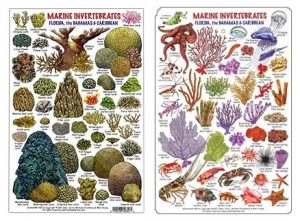
Fun Coral Facts
It’s quite easy, and common, for people to mistake coral for plants and rocks because of the way they look. However, corals are actually animals with plant like cells living inside of it. Corals are made up of a very slow growing organism called a polyp. Each polyp has a mouth and a stomach, and a new coral will start from a single polyp which will then grow and divide (at an average rate of just 2cm to 10cm per year) over hundreds of years to form large colonies that can actually be seen from outer space. Coral needs sunlight to grow so the hard and soft varieties thrive in shallower depths, although deep water coral which doesn’t need sunlight can be found in very cold waters and in depths reaching 2,000 meters / 6,000+ feet.
When corals reproduce, fertilized eggs form tiny swimming coral larvae that can ride the ocean currents until finding a suitable place to live where they can swim down and attach themselves to the ocean floor to grow into a new colony. Coral reefs are made up of many coral colonies. There are hundreds of different coral species in all shape, sizes, and colors. Even though coral reefs make up less than 1% of the ocean, all the nooks and crannies in the corals provide a home for more than 25% of the worlds marine life consisting of over 4,000 different species of fish.
Like their jellyfish cousins, each corral polyp has stinging cells in their tentacles that they use like harpoons to catch their food. Corals eat plankton and small fish, but it also provides a home and protection for algae that lives inside its cells that uses sunlight to produce food for the coral as well. This algae is also what gives the coral all its beautiful and amazing array of colors. In addition, the corals act like sponges and feed on all the small particles in the ocean which cleans the water and keeps it clear.
It goes without saying that Coral reefs provide major benefits to the world in a variety of ways. They protect coastal shores from up to 90% of potentially damaging storms and flooding. They provide food for a variety of fish which is then estimated to feed over 500 million people. Coral reefs are a huge driver of tourism. It’s estimated that over 70 million people visit coral reefs every year. Coral reefs provide important resources for medicines that are being used to treat cancer, heart disease, Alzheimer’s, arthritis, bacterial infections, and more. It’s estimated that benefits coral reefs provide is worth $10 trillion per year.
Coral has one of the longest lifespans of any animal. Most established coral reefs are between 5,000 and 10,000 years old. Many scientist say in perfect conditions, coral could live forever. It is believed that the oldest coral reef found on earth was formed 480 million years ago, and is located in the tropical waters of what was once the Lapetus ocean. Coral reefs are very fragile and their greatest threats come from environmental changes caused by greenhouse gas emissions. Coral bleaching is a stress reaction that the coral has when the water is too warm. The coral expels the symbiotic algae living inside it, and it loses nutrition and turns white due to starvation. Human activity from over fishing to the ingredients in our sunscreen threaten coral reefs as well. Corals can return from these experiences, but need our help.
What can you do to help? Let’s start with the obvious; never liter (one of the biggest polluters of the ocean and harmful to all living species big and small) or step on/touch the corals. Never purchase coral souvenirs or remove anything from the ocean (dead or alive, except for liter). Try to pack reef-safe soaps, shampoos, and sunscreen to avoid damaging corals with harsh chemicals. Bring along a reusable water bottle and eating utensils to cut down on single use plastic items. When diving or snorkeling, try to be aware of your fins so you don’t stir up any sediment which can smother corals.